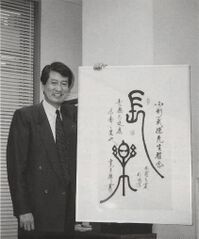Difference between revisions of "Takenori Ogata"
From Sega Retro
m (→Career) |
m |
||
| Line 2: | Line 2: | ||
| image=Takenori Kogata 1994.jpg | | image=Takenori Kogata 1994.jpg | ||
| birthplace=Japan | | birthplace=Japan | ||
| − | | dob=1939-09{{ref|https://web.archive.org/web/ | + | | dob=1939-09{{ref|https://web.archive.org/web/20220130023734/https://find-and-update.company-information.service.gov.uk/officers/WhslKboxHE88i16iglhWTYcwYWI/appointments}} |
| dod= | | dod= | ||
| company=[[Rosen Enterprises]], [[Sega of Japan]], [[Sega Amusements Europe]] | | company=[[Rosen Enterprises]], [[Sega of Japan]], [[Sega Amusements Europe]] | ||
Revision as of 13:45, 7 June 2022

|
| Takenori Ogata |
|---|
| Place of birth: Japan |
| Date of birth: 1939-09[1] (age 85) |
| Company(ies): Rosen Enterprises, Sega of Japan, Sega Amusements Europe |
| Role(s): Vice President, Manager, Director, Salesman |
Takenori Ogata (小形 武徳) is a former Japanese salesman. From 1965 to 1998, he managed Sega's amusement machine sales divisions, with involvement dating back to Rosen Enterprises in 1964 before its merger. At the time of his retirement in 1998, he was a vice president of the company.[2]
Ogata is credited with considerable influence in selling much of Sega's successful arcade produce, as well as establishing its prize manufacturing and sales business for the UFO Catcher line.[3]
Career
Born in September 1939, Takenori Ogata endeavoured to become a salesman. His first sales work in the 1950s was for model slot car manufacturers, before pivoting to become a stockbroker.[4] Taking the recommendation of quitting this career in the wake of the assassination of John F. Kennedy and resultant stock market crash,[4] he moved back into sales on his initial enjoyment of the profession and love for play, joining Rosen Enterprises during 1964.[4] This decision was inspired by finding David Rosen's coin-operated amusement machines at a US military base club he had recently visited with a friend.[4]
Following Rosen Enterprises' merger with Nihon Goraku Bussan to create Sega Enterprises in 1965, Ogata would continue working in amusement machine sales. He played a crucial role in selling Olympia Star and Harness Race.[4] The latter in particular was being sold reluctantly by Sega due to its high cost;[4] however, as a result of Ogata's close relationship with the Casino Game Las Vegas (later Shinjuku Playland Carnival[5]) game center in Kabukicho, he was able to sell the machine to them with trust.[4] Harness Race became a success at the location, resulting in many others following suit. Around 500 units were eventually sold.[4]
As general manager of amusement machine sales division in the latter half of the 1980s,[6] Ogata established and grew a lucrative prize sales and manufacturing business for Sega's UFO Catcher machines;[3] this move was triggered by his discovery of ¥100 plush toys for sale on a business trip to Seoul, South Korea, the manufacturers of which he immediately contracted.[7] Regulations at the time had meant that only products below ¥200 could be placed in the cabinets.[7] Alongside an eventual relaxation of these regulations allowing for more elaborate prizes, this created a successful, enduring sales model for the company.
Ogata remained in charge of amusement machine sales, as well as marketing, into the 1990s.[8] Among fellow influential senior employees Hisashi Suzuki, Hideki Sato, and Akira Nagai, he was interviewed in 1995 book Sogo Amusement Kigyo Sega.[9] His senior position also led to numerous features in Sega's internal newsletter Harmony,[10][4] as well as involvement with overseas sales colleagues at Sega Enterprises USA[11][12] and eventually Sega Amusements Europe.[1][13] By then a vice president, he retired from Sega in June 1998;[2] it has been suggested this was in part due to Hayao Nakayama's prior resignation.[3]
Over 40 years after joining Rosen Enterprises, Ogata and Nakayama latterly attended a party held with Rosen on cruise ship The World during April 2006.[14]
Photographs
- Main article: Photos of Takenori Ogata
Magazine articles
- Main article: Takenori Ogata/Magazine articles.
External links
References
- ↑ 1.0 1.1 https://find-and-update.company-information.service.gov.uk/officers/WhslKboxHE88i16iglhWTYcwYWI/appointments (Wayback Machine: 2022-01-30 02:37)
- ↑ 2.0 2.1 https://www.ampress.co.jp/backnumber/bn1998.06.15.htm (Wayback Machine: 2001-03-06 22:17)
- ↑ 3.0 3.1 3.2 https://blog.goo.ne.jp/lemon6868/e/f2cf26d65075b9d67628a104bd2ceaec (Wayback Machine: 2021-10-10 18:49)
- ↑ 4.0 4.1 4.2 4.3 4.4 4.5 4.6 4.7 4.8 Harmony, "1994 4" (JP; 1994-04-01), page 48
- ↑ https://www.asahi.com/ajw/articles/14054079 (Wayback Machine: 2021-08-23 07:35)
- ↑ Game Machine, "1986-11-01" (JP; 1986-11-01), page 16
- ↑ 7.0 7.1 https://geolog.mydns.jp/www.geocities.jp/rekisihu/tero-1.html (Wayback Machine: 2022-01-25 18:50)
- ↑ File:AnnualReport1995 English.pdf, page 22
- ↑ http://www.web-japan.to/book/review_sega.htm (Wayback Machine: 2001-12-26 05:59)
- ↑ Harmony, "1994 1" (JP; 1994-01-01), page 20
- ↑ Vending Times, "Volume 29, No. 10: August 1989" (US; 1989-xx-xx), page 35
- ↑ Cash Box, "August 26, 1989" (US; 1989-08-26), page 30
- ↑ http://www.checkcompany.co.uk/director/7296139/TAKENORI-OGATA (Wayback Machine: 2022-05-05 18:45)
- ↑ https://www.ampress.co.jp/backnumber/bn2006.05.01.htm (Wayback Machine: 2016-09-12 08:53)